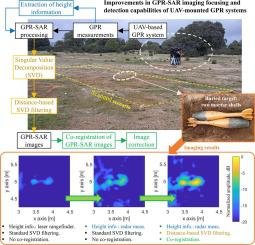ISPRS Journal of Photogrammetry and Remote Sensing ( IF 10.6 ) Pub Date : 2022-05-14 , DOI: 10.1016/j.isprsjprs.2022.04.014 María García-Fernández , Guillermo Álvarez-Narciandi , Yuri Álvarez López , Fernando Las-Heras Andrés

|
In recent years there has been an increasing research interest in the development of airborne-based Ground Penetrating Radar (GPR) systems for safe and fast detection of buried threats such as landmines and Improvised Explosive Devices (IEDs). Compared to other sensors such as metal detectors or magnetometers, GPR is able to detect either metallic and non-metallic targets. Besides, the use of Ultra Wide Band (UWB) radiofrequency hardware allows retrieving high resolution images of the subsoil, thus improving the detection capabilities. Airborne-based GPR systems are affected by uncertainties that need to be characterized and corrected. This contribution focuses on the following three issues: (i) influence of the height information in the GPR-Synthetic Aperture Radar (GPR-SAR) images, determining which sensors provide better quality images; (ii) distortion of the imaged targets in along-track axis due to small tilting of the UWB antennas on board the UAV, proposing a co-registration technique to correct it; and (iii) revision of SVD filtering techniques, assessing a criterion to classify the different eigenimages. The analysis of these issues, as well as the validation of the proposed correction methods, are conducted using measurements taken during validation campaigns of the implemented airborne-based GPR system. For this purpose, two validation scenarios with different soil characteristics have been selected. Metallic and non-metallic targets with different shapes and sizes have been buried in them. In the case of the first scenario (wet loamy soil), detection capabilities improved from 50% (5 out of 10 targets were detected) to 80%. For the second validation scenario (loamy soil, but less humid than the first scenario), not only a 100% detection is achieved, but also the targets are clearly imaged in the GPR-SAR images obtained with the improvements presented in this contribution.
中文翻译:

无人机挂载探地雷达系统探地雷达成像聚焦和探测能力的改进
近年来,人们越来越关注开发机载探地雷达 (GPR) 系统,以安全和快速地检测埋藏的威胁,例如地雷和简易爆炸装置 (IED)。与金属探测器或磁力计等其他传感器相比,GPR 能够探测金属和非金属目标。此外,超宽带 (UWB) 射频硬件的使用允许检索底土的高分辨率图像,从而提高检测能力。机载 GPR 系统受到需要表征和纠正的不确定性的影响。该贡献集中在以下三个问题:(i)GPR-合成孔径雷达(GPR-SAR)图像中高度信息的影响,确定哪些传感器提供更好的图像质量;(ii) 由于 UAV 上的 UWB 天线的小倾斜导致沿航迹轴成像目标的失真,提出了一种联合配准技术来纠正它;(iii) 修改 SVD 过滤技术,评估分类不同特征图像的标准。对这些问题的分析,以及对所提出的校正方法的验证,是使用在已实施的机载 GPR 系统的验证活动期间进行的测量进行的。为此,选择了两种具有不同土壤特性的验证方案。其中埋有不同形状和大小的金属和非金属靶材。在第一种情况下(潮湿的壤土),检测能力从 50%(检测到 10 个目标中的 5 个)提高到 80%。对于第二个验证场景(壤土,











































 京公网安备 11010802027423号
京公网安备 11010802027423号